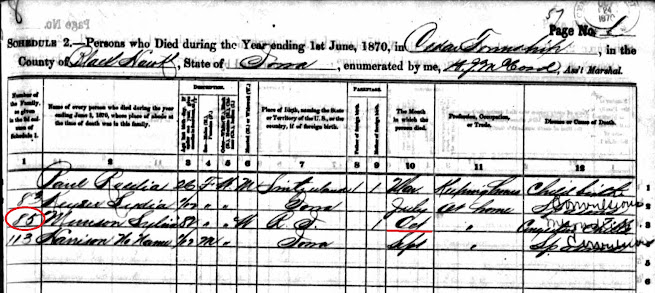 |
| Photo courtesy of Linnaea Mallette on PublicDomainPictures.net |
Death records of our ancestors are one of the primary sources that family historians are constantly searching for. They can lead to information on other family members, burial sites, cause of death and estate records.
Formal death records are usually available from 1900 onward in the U.S.. A few states, like Ohio, started recording death information in the latter half of the 19th century. Most New England states recorded all vital records much earlier. Tombstones and church records are often used as substitutes for formal death records.
But what if death record, tombstone or church records aren't available?
Another possible substitute is the Federal Mortality Schedules, if your ancestor died in the 12 months prior to the enumeration of the U.S. Federal Censuses in 1850, 1860, 1870, 1880 and 1885.
The federal government wasn't receiving information on deaths from the states and they wanted to know causes of death and if certain ages or occupations were more susceptible. With the Mortality Schedules, the national policy makers had countrywide death statistics for the first time.
What information do they contain?
The information found in the schedules varies with the year and the caprice of the individual enumerators.
1850-1860 - also only place a slave ancestor's death might be recorded
- Name
- Age at last birthday
- Sex
- Race - free or slave
- Marital status
- Place of birth
- Profession, occupation, or trade
- Length of residence in county
- Month in which person died
- Disease or cause of death
- Number of days ill
 |
| 1850 Mortality Schedule from Mecklenburg County, North Carolina NOTE: the red arrow indicates column where free/slave status is listed. Accessed from Ancestry Library Edition on 7 June 2021. |
 |
| 1850 Mortality Schedule from Woodford County, Kentucky. This enumerator chose NOT to list enslaved people by name. Accessed from Ancestry Library Edition on 7 June 2021. |
 |
| Excerpt from the 1860 Tuscaloosa County, Alabama Mortality Schedule. Accessed from Ancestry Library Edition on 7 June 2021. |
- If father and/or mother were foreign born
- Removed the question about how many days the deceased was ill
- Family number included which ties the entry back to a specific entry in the population schedule. (If it was filled in.)
 |
| Family #85, Levi and Lucy Ann MUNSON is the household where Sylvia (above) was living at the time of her death. Is there a familial relationship? Accessed from Ancestry Library Edition on 8 June 2021. |
- Place of birth of mother and father
- How long they had resided in the county
- Where the disease was contracted if not at place of death
- Name of attending physician
- Family number included which ties the entry back to a specific entry in the population schedule. (If it was filled in.)
 |
| Who is this Rucker family? What is their relationship to John WILLIAMS? Is Susan RUCKER, John's daughter? Accessed from FamilySearch.org 8 June 2021 |
- The Federal government offered to partially reimburse states that wanted to take a census in 1885. Colorado, Florida, Nebraska, and the territories of Dakota and New Mexico participated. However, the territories' mortality schedules are not on Ancestry, FamilySearch or Heritage Quest.
Where do you find Mortality Schedules?

- National Archives - the National Archives has microfilm copies that usually can be ordered. Check out the microfilm catalog in the "Where to Find these Records" box on the right. Forms that show the column headings for the Mortality Schedules can be found HERE.
- State historical societies, archives and state libraries. (pp. 24-25 of Stephen Charter's work listed below under Sources)
- Printed indexes - Check WorldCat to see who owns it. Remember! Printed indexes are a last resort. You always want to see the full document for information not listed in the index.
Coverage/Completeness of the records
- These states' mortality schedules are NOT listed on Ancestry or Heritage Quest:
- Florida
- Indiana
- Oregon
- Rhode Island
- Vermont, 1850-1860
- Wisconsin, 1880
- These states, while not listed on Ancestry/HeritageQuest, ARE HELD at FamilySearch.org:
- Florida 1860, 1880
- Indiana, 1860-1880
- Wisconsin, 1880
- Before the National Archives was created, the government offered the original mortality schedules to each of the states. If the state did not accept, the manuscripts were sent to the National Library of the Daughters of the American Revolution (DAR).
- States that were still U.S. territories are not covered.
- 1870 is missing for 7 states: Delaware, Florida, Indiana, Mississippi, Missouri, Ohio, Rhode Island, Tennessee.
- The Census Bureau has a list of known coverage of the mortality schedules: https://www.census.gov/history/pdf/mortality.pdf
Follow up the information found in the Mortality Schedules by searching for obituaries, mortuary records, cemeteries, and probate records. They can also provide clues to migration points and they supplement information found in the population schedules.
- Theusch, Cynthia, "Mortality (Non-Population) Schedules", Allen County Public Library,
- Hendrickson, Nancy, "Searching in a Mortality Schedule on Ancestry.com" "Family Tree Magazine, https://www.familytreemagazine.com/websites/ancestry-help/ancestry-mortality-schedule-tutorial/
- Szucs, Loretto, et al, The Source: A Guidebook of American Genealogy, 2006.
- Szucs, Loretto, et al, Finding Answer in the U.S. Census Records, 2001.
- Charter, Stephen, The United States Census Mortality Schedule Register, http://www.familysearch.org/library/books/records/item/59602-united-states-census-mortality-schedule-register
- Crow, Amy Johnson, "Using Mortality Schedules: An Overlooked Source for Genealogy" https://www.amyjohnsoncrow.com/using-mortality-schedules-an-overlooked-source-for-genealogy/ , 2019
- "Mortality Schedules", United States Census Bureau, https://www.census.gov/history/www/genealogy/other_resources/mortality_schedules.html






















No comments:
Post a Comment